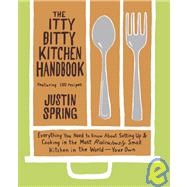
JUSTIN SPRING is an award-winning biographer, curator, and art historian who has published many feature articles on home design in The New York Times Home section, Martha Stewart Living, and Mary Emmerling’s Country. He has lived very happily with his own itty-bitty kitchen (in midtown Manhattan) for more than twelve years.
The New copy of this book will include any supplemental materials advertised. Please check the title of the book to determine if it should include any access cards, study guides, lab manuals, CDs, etc.
The Used, Rental and eBook copies of this book are not guaranteed to include any supplemental materials. Typically, only the book itself is included. This is true even if the title states it includes any access cards, study guides, lab manuals, CDs, etc.
Excerpted from The Itty Bitty Kitchen Handbook: Everything You Need to Know about Setting up and Cooking in the Most Ridiculously Small Kitchen in the World--Your Own by Justin Spring
All rights reserved by the original copyright owners. Excerpts are provided for display purposes only and may not be reproduced, reprinted or distributed without the written permission of the publisher.